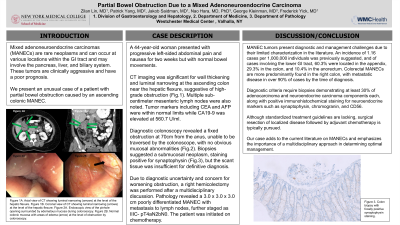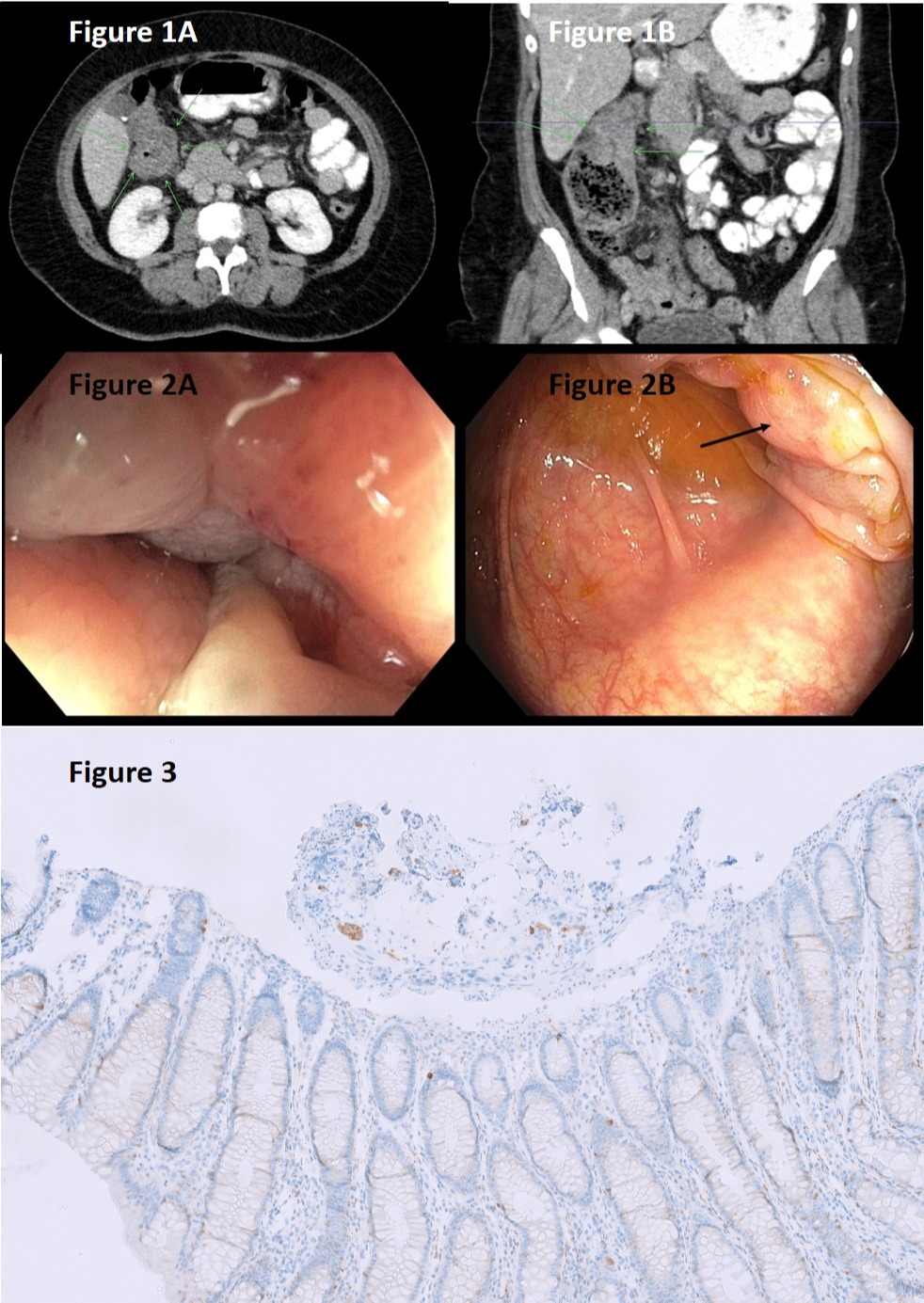Monday Poster Session
Category: Colon
P1653 - Partial Bowel Obstruction Due to a Mixed Adenoneuroendocrine Carcinoma
Monday, October 23, 2023
10:30 AM - 4:15 PM PT
Location: Exhibit Hall

Has Audio
- ZL
Zilan Lin, MD
Westchester Medical Center
Valhalla, NY
Presenting Author(s)
Zilan Lin, MD, Patrick Yang, MD, Jakob Saidman, MD, Nao Hara, MD, PhD, George Kleinman, MD, Frederick Yick, MD
Westchester Medical Center, Valhalla, NY
Introduction: Mixed adenoneuroendocrine carcinomas (MANECs) are rare neoplasms. They can occur at various locations within the GI tract and may involve the pancreas, liver, and biliary system. These tumors are clinically aggressive and have a poor prognosis. We present an unusual case of a patient with partial bowel obstruction caused by an ascending colonic MANEC.
Case Description/Methods: A 44-year-old woman presented with progressive left-sided abdominal pain and nausea of two weeks. She reported having normal bowel movements. CT imaging showed wall thickening and luminal narrowing at the ascending colon near the hepatic flexure, suggestive of high-grade obstruction (Fig.1). Multiple sub-centimeter mesenteric lymph nodes were also noted. Tumor markers including CEA and AFP were within normal limits while CA19-9 was elevated at 560.7 U/ml. Diagnostic colonoscopy revealed a fixed obstruction at 70cm from the anus, unable to be traversed by the colonoscope, with no obvious mucosal abnormalities (Fig.2). Biopsies suggested a submucosal neoplasm staining positive for synaptophysin (Fig.3), but the scant tissue was insufficient for definitive diagnosis. Due to diagnostic uncertainty and concern for worsening obstruction, after discussion involving multiple specialties, a right hemicolectomy was performed. Pathology revealed a 3.0 x 3.0 x 3.0 cm poorly differentiated MANEC with metastasis to lymph nodes, further staged as IIIC- pT4aN2bN0. The patient was initiated on CAPOX chemotherapy.
Discussion: MANEC tumors present diagnostic and management challenges due to their limited characterization in the literature. An incidence of 1.16 cases per 1,000,000 individuals was previously suggested, and of cases involving the lower GI tract, 60.3% were located in the appendix, 29.3% in the colon, and 10.4% in the anorectum. Colorectal MANECs are more predominantly found in the right colon, with metastatic disease in over 90% of cases by the time of diagnosis. Diagnostic criteria require biopsies demonstrating at least 30% of adenocarcinoma and neuroendocrine carcinoma components each, along with positive immunohistochemical staining for at least two of three markers including synaptophysin, chromogranin and CD56. Although standardized treatment guidelines are lacking, surgical resection of localized disease followed by adjuvant chemotherapy is typically pursued. Our case adds to the current literature on MANECs and emphasizes the importance of a multidisciplinary approach in determining optimal management.

Disclosures:
Zilan Lin, MD, Patrick Yang, MD, Jakob Saidman, MD, Nao Hara, MD, PhD, George Kleinman, MD, Frederick Yick, MD. P1653 - Partial Bowel Obstruction Due to a Mixed Adenoneuroendocrine Carcinoma, ACG 2023 Annual Scientific Meeting Abstracts. Vancouver, BC, Canada: American College of Gastroenterology.
Westchester Medical Center, Valhalla, NY
Introduction: Mixed adenoneuroendocrine carcinomas (MANECs) are rare neoplasms. They can occur at various locations within the GI tract and may involve the pancreas, liver, and biliary system. These tumors are clinically aggressive and have a poor prognosis. We present an unusual case of a patient with partial bowel obstruction caused by an ascending colonic MANEC.
Case Description/Methods: A 44-year-old woman presented with progressive left-sided abdominal pain and nausea of two weeks. She reported having normal bowel movements. CT imaging showed wall thickening and luminal narrowing at the ascending colon near the hepatic flexure, suggestive of high-grade obstruction (Fig.1). Multiple sub-centimeter mesenteric lymph nodes were also noted. Tumor markers including CEA and AFP were within normal limits while CA19-9 was elevated at 560.7 U/ml. Diagnostic colonoscopy revealed a fixed obstruction at 70cm from the anus, unable to be traversed by the colonoscope, with no obvious mucosal abnormalities (Fig.2). Biopsies suggested a submucosal neoplasm staining positive for synaptophysin (Fig.3), but the scant tissue was insufficient for definitive diagnosis. Due to diagnostic uncertainty and concern for worsening obstruction, after discussion involving multiple specialties, a right hemicolectomy was performed. Pathology revealed a 3.0 x 3.0 x 3.0 cm poorly differentiated MANEC with metastasis to lymph nodes, further staged as IIIC- pT4aN2bN0. The patient was initiated on CAPOX chemotherapy.
Discussion: MANEC tumors present diagnostic and management challenges due to their limited characterization in the literature. An incidence of 1.16 cases per 1,000,000 individuals was previously suggested, and of cases involving the lower GI tract, 60.3% were located in the appendix, 29.3% in the colon, and 10.4% in the anorectum. Colorectal MANECs are more predominantly found in the right colon, with metastatic disease in over 90% of cases by the time of diagnosis. Diagnostic criteria require biopsies demonstrating at least 30% of adenocarcinoma and neuroendocrine carcinoma components each, along with positive immunohistochemical staining for at least two of three markers including synaptophysin, chromogranin and CD56. Although standardized treatment guidelines are lacking, surgical resection of localized disease followed by adjuvant chemotherapy is typically pursued. Our case adds to the current literature on MANECs and emphasizes the importance of a multidisciplinary approach in determining optimal management.

Figure: Figure 1A. Axial view of CT showing luminal narrowing (arrows) at the level of the hepatic flexure. Figure 1B. Coronal view of CT showing luminal narrowing (arrows) at the level of the hepatic flexure. Figure 2A. Endoscopic view of the pinhole opening surrounded by edematous mucosa during colonoscopy. Figure 2B. Normal colonic mucosa with areas of edema (arrow) at the level of obstruction by colonoscopy. Figure 3. Colon biopsy with focally positive synaptophysin staining.
Disclosures:
Zilan Lin indicated no relevant financial relationships.
Patrick Yang indicated no relevant financial relationships.
Jakob Saidman indicated no relevant financial relationships.
Nao Hara indicated no relevant financial relationships.
George Kleinman indicated no relevant financial relationships.
Frederick Yick indicated no relevant financial relationships.
Zilan Lin, MD, Patrick Yang, MD, Jakob Saidman, MD, Nao Hara, MD, PhD, George Kleinman, MD, Frederick Yick, MD. P1653 - Partial Bowel Obstruction Due to a Mixed Adenoneuroendocrine Carcinoma, ACG 2023 Annual Scientific Meeting Abstracts. Vancouver, BC, Canada: American College of Gastroenterology.
